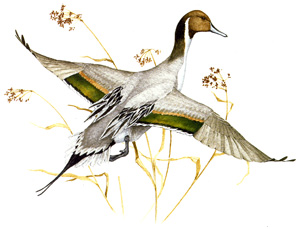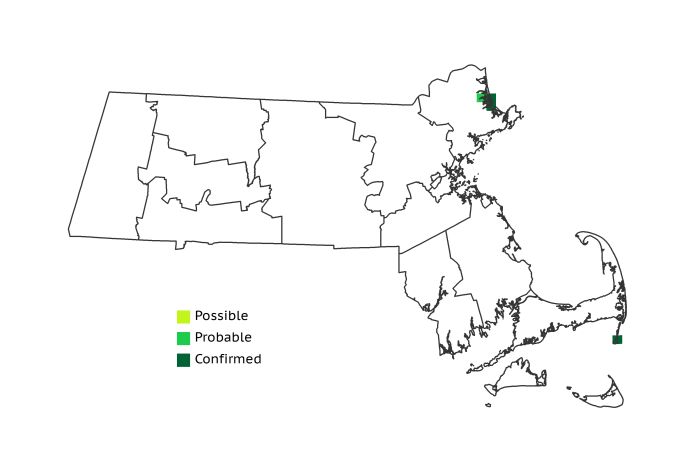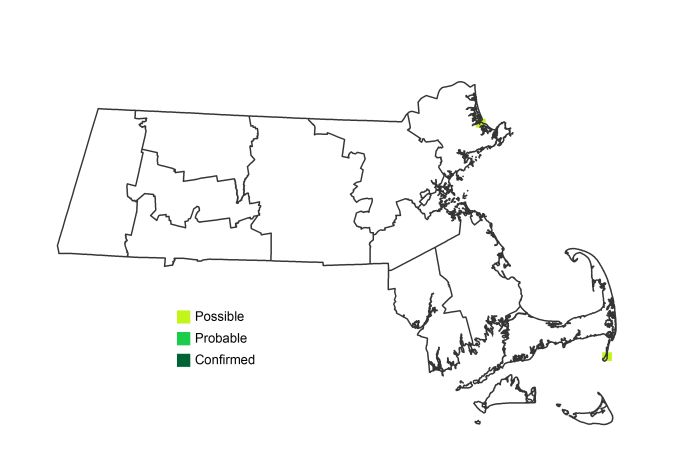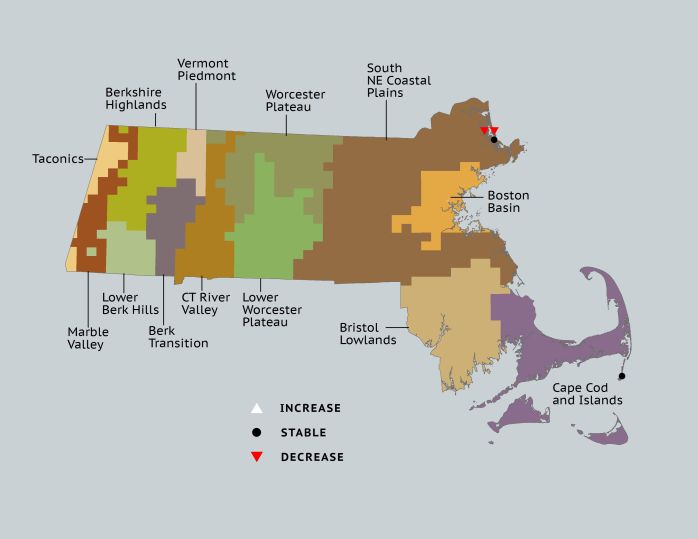Breeding Bird Atlases (BBA)
Find a Bird
Northern Pintail
Anas acuta

Very local, trend not established
“Northward, ever northward, clearly indicated on the distant sky, points the long slim figure of the pintail, in the vanguard of the spring migration, wending its way toward remote and still frozen shores.” – Arthur Cleveland Bent, Life Histories of North American Wild Fowl
Although only the males in breeding plumage have the long, sharp tail plumes for which the species is named, Northern Pintails are always recognizable among other ducks thanks to their long necks and slender builds. This species breeds in wetlands all across the Northern Hemisphere, but in North America most of its range lies in the extensive prairies located in the western half of the continent. The hardiest individuals breed even in the most northern parts of Alaska. Northern Pintails also breed regularly in the Maritime Provinces of Canada, and occasionally – very occasionally – a pair will make its way south to breed in the Bay State.
Historic Status
If you asked any Massachusetts ornithologist of old, he would tell you the same sad tale; that the Northern Pintail is a beautiful bird but is rarely seen ’round these parts. From the earliest accounts, Northern Pintails were regarded as migration specialties in the Bay State and generally rarer in spring than in autumn. “It is regrettable,” said Edward Howe Forbush, “that this splendid bird is not more common in New England” (Forbush 1925). About the time that thirty ducklings of this species were released at the newly created Ipswich River Wildlife Sanctuary in Topsfield in the 1950s, this species began nesting occasionally at Plum Island.
Atlas 1 Distribution
Far from the prairie potholes they normally call home, breeding Northern Pintails were few in Atlas 1. The birds introduced at Ipswich River no longer occupied that area, though it is possible that their descendants could have been among the few birds that did breed in Massachusetts during the Atlas 1 period. The refuge ponds and marshes of Plum Island hosted 3 of the 4 blocks found statewide in Atlas 1, and the final Confirmation came from South Monomoy Island.
Atlas 2 Distribution and Change
During Atlas 2 Northern Pintails were found at Parker River and Monomoy National Wildlife Refuges during the Safe Date period, but they were not Confirmed as breeders. In all likelihood, the Northern Pintail will continue to be an irregular and highly local breeder in Massachusetts for the foreseeable future.
Atlas 1 Map

Atlas 2 Map

Atlas Change Map

Ecoregion Data
Atlas 1 | Atlas 2 | Change | ||||||
Ecoregion | # Blocks | % Blocks | % of Range | # Blocks | % Blocks | % of Range | Change in # Blocks | Change in % Blocks |
Taconic Mountains | 0 | 0.0 | 0.0 | 0 | 0.0 | 0.0 | 0 | 0.0 |
Marble Valleys/Housatonic Valley | 0 | 0.0 | 0.0 | 0 | 0.0 | 0.0 | 0 | 0.0 |
Berkshire Highlands | 0 | 0.0 | 0.0 | 0 | 0.0 | 0.0 | 0 | 0.0 |
Lower Berkshire Hills | 0 | 0.0 | 0.0 | 0 | 0.0 | 0.0 | 0 | 0.0 |
Vermont Piedmont | 0 | 0.0 | 0.0 | 0 | 0.0 | 0.0 | 0 | 0.0 |
Berkshire Transition | 0 | 0.0 | 0.0 | 0 | 0.0 | 0.0 | 0 | 0.0 |
Connecticut River Valley | 0 | 0.0 | 0.0 | 0 | 0.0 | 0.0 | 0 | 0.0 |
Worcester Plateau | 0 | 0.0 | 0.0 | 0 | 0.0 | 0.0 | 0 | 0.0 |
Lower Worcester Plateau | 0 | 0.0 | 0.0 | 0 | 0.0 | 0.0 | 0 | 0.0 |
S. New England Coastal Plains and Hills | 3 | 1.1 | 75.0 | 1 | 0.4 | 50.0 | -2 | -0.9 |
Boston Basin | 0 | 0.0 | 0.0 | 0 | 0.0 | 0.0 | 0 | 0.0 |
Bristol and Narragansett Lowlands | 0 | 0.0 | 0.0 | 0 | 0.0 | 0.0 | 0 | 0.0 |
Cape Cod and Islands | 1 | 0.7 | 25.0 | 1 | 0.7 | 50.0 | 0 | 0.0 |
Statewide Total | 4 | 0.4 | 100.0 | 2 | 0.2 | 100.0 | -2 | -0.2 |
Notes
Northern Pintails show a significant decreasing Breeding Bird Survey trend in the Eastern US overall.



